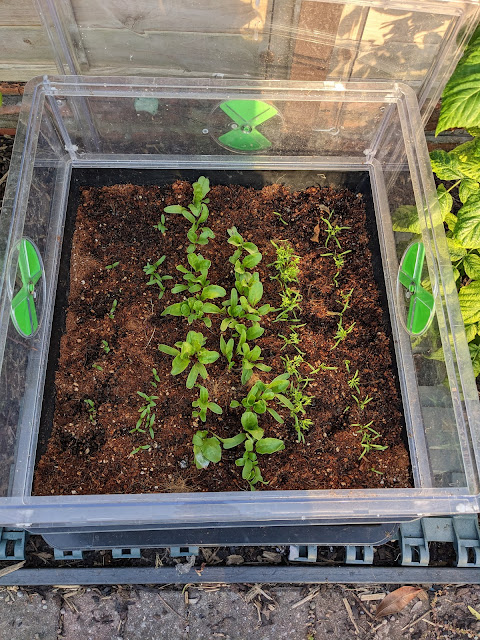"When you get down to it, as sooner or later you must, gardening is a long-drawn-out war of attrition against the elements, a tripartite agreement involving the anaimal, insect and bird worlds, and the occasional sheer perversity of Nature" - Alan Melville
 |
| Photo 1: Beetroot & Parsnip Bed (4th June) |
In an earlier post, I mentioned that it had been a slow start to the growing season. I attributed this, partly, to my tardiness and the less-than-ideal weather conditions (too dry/cold) but also to a reluctance on the part of my vegetable seeds to germinate! Most packets of seeds contain far more than you need for one growing season, so frugal gardeners save unwanted seeds for the following year. Because seed viability decreases with age, I just assumed that was the reason for the poor germination rates this year; except some seeds (e.g. squash and sweetcorn) bought this year also had a low success rate for germination. Of course, there is always the chance a particular packet of seeds is 'bad' but I am more inclined to think it may have been down to using an old bag of seed compost. You should always use the 'freshest' compost you can whether seed, multipurpose, or potting - it ain't always nifty to be thrifty.
My beetroot & parsnip seeds were sown directly in the ground on the 8th of April - two rows of each. Some extra watering was required during May which had little rain. Photo 1 shows the parsnip/beetroot patch on the 4th of June. One measly parsnip plant but at least they had outperformed the beetroot which couldn't muster a single specimen.
On May 20th, further batches of beetroot, carrot, and parsnip seed were sown in one of my small Veg/Salad Planters (Greenhouse Sensation) - Photo 2.
 |
| Photo 2: Veg/Salad Planter as Seed Beed |
 |
| Photo 3: Veg/Salad Planter as Mini-Greenhouse |
Nearly three weeks later, the root vegetables had germinated (Photo 4) and it was time to transplant the seedlings into their final growing position.
 |
| Photo 4: Parsnip, Beetroot, Carrot Seedlings (L to R) |
Using a coir-based compost for the seed nursery makes it very easy to extract the individual seedlings, even those that are still quite small ...
 |
| Photo 5: Seed Nursery Close-up |
... the beetroot (middle) and carrot (right) had grown to a reasonable size though the parsnips were somewhat underdeveloped (Photo 5). There are clear and obvious benefits to sowing direct (e.g. less root disturbance) but they do need constant attention to ensure sufficient warmth and water.
For the transplanting, I used a trowel to cut a V-shaped drill, about 5 centimetres deep, and flooded this with a dilute solution of balanced fertilizer to give the seedlings an immediate boost. The V-shaped drill was filled with sieved homemade compost (soil conditioner) and individual seedlings planted into a hole made with a gloved finger. The whole bed was then watered with dilute fertilizer solution, to settle the seedlings in (Photo 6). Note the insect mesh barrier to combat onion and carrot fly and the companion planting of onions/garlic with carrots.
 |
| Photo 6: Young beetroot and parsnip plants after watering in |
The following day I covered the newly planted root crop with insect mesh (Photo 7).
Why use insect mesh protection? Well, not primarily for protection against small flying pests - although that is always a concern with carrot fly especially when transplanting the seedlings. The main reason for using insect mesh in this instance was to: (i) help retain soil moisture (it hadn't rained for about a month), (ii) provide some shade (the hottest day of the year was imminent), and (iii) offer some protection against predicted thunderstorms and heavy rainfall (possibly hail).
 |
| Photo 7: Protection for the newly planted root seedlings |
The seedlings were transplanted during the evening of June 9th (a warm sunny day with a maximum temperature of 26 ℃) - not ideal but then things seldom are with gardening - and watered in. June 10th was the hottest day, so far, for 2023. Temperatures reached 30 ℃ in the kitchen garden but the young transplants survived without any problem (Photo 8 & 9).
 |
| Photo 8: Young Beetroot Plant (11th June) |
 |
| Photo 9: Young Carrot Plants (11th June) |
The predicted storms (thunder, lightning, heavy rain but no hail) arrived on June 12th and the plants survived.






0 comments:
Post a Comment